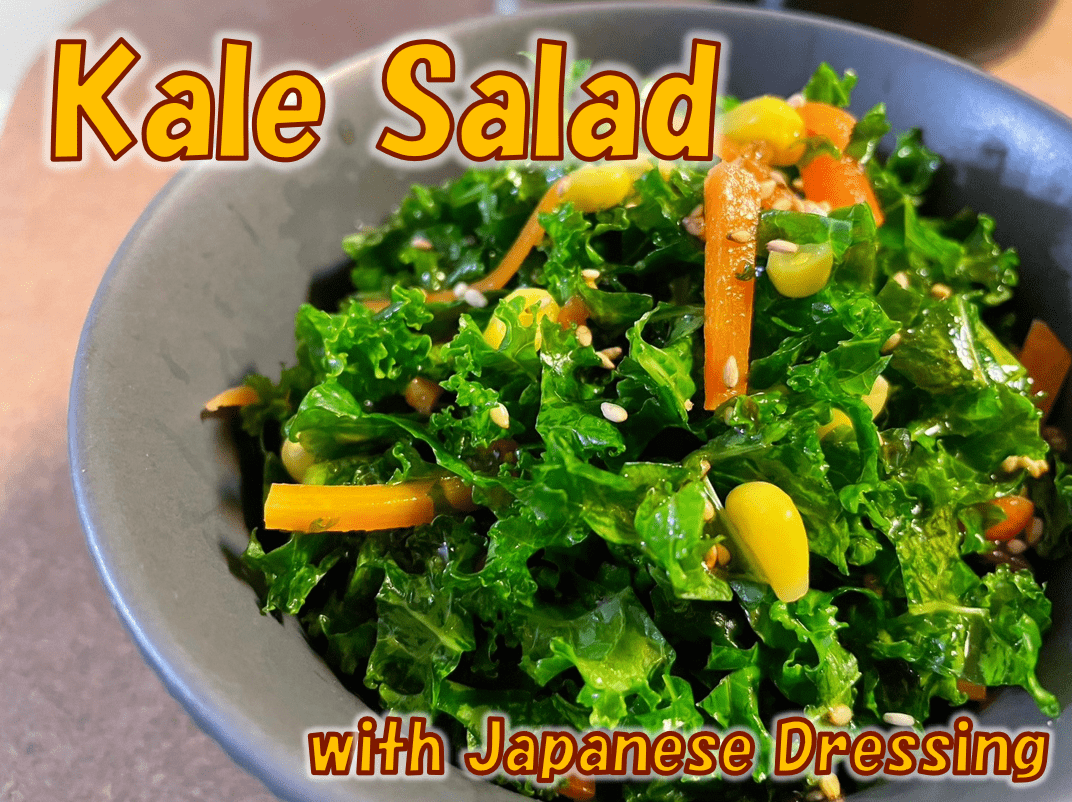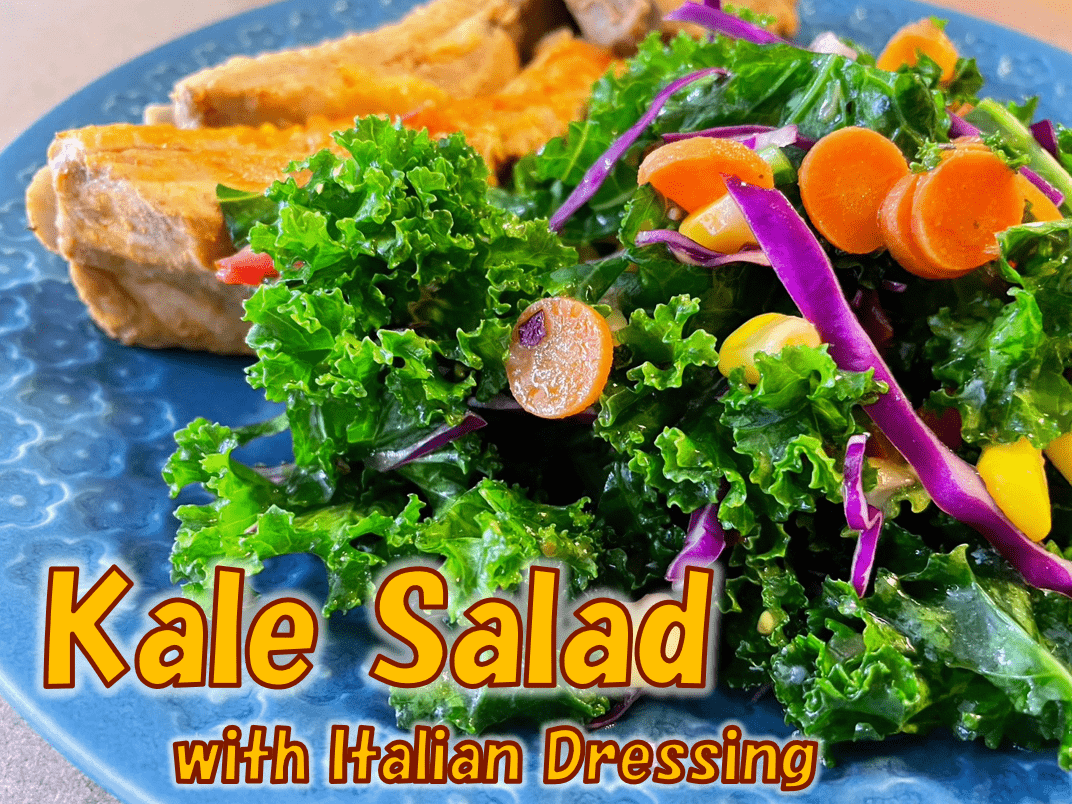For those who want to see the recipe right away, you can check it out here.
Hello, I’m Tomo_Kitchen (@tomo_kitchen883)! This time, I tried making a “Kale Salad with Japanese Dressing” using kale. Feeling a bit low on nutrients or swamped with work? I’ve got the perfect solution for you – an easy yet nutritious powerhouse, the “Kale Salad with Japanese Dressing” Crunchy kale and Japanese flavor are superb! The refreshing aroma of the dressing envelopes the entire dish, making it healthy and delicious that you will never get tired of…♪ Nutritious and with an added Japanese element, it will turn your everyday meal into something special.
In this “Kale Salad with Japanese Dressing” that I made this time, I’ve used a generous amount of kale. Although not widely known, kale actually boasts three incredible nutrients! By exploring the nutritional benefits and effects of kale, you can incorporate a balanced intake of essential nutrients into your dinner recipes and meal plans. I hope this information can contribute to maintaining your health.
Things You Didn’t Know About ”Kale”
Are you familiar with kale, the nutrient-packed, vibrant green vegetable? This superfood is gaining international attention, often used by celebrities worldwide in salads, smoothies, and even as an ingredient in green juices for both beauty and health benefits. In this article, we’ll explore the high nutritional value of kale that has captured the world’s interest, and provide tips on how to deliciously incorporate it into your daily meals.
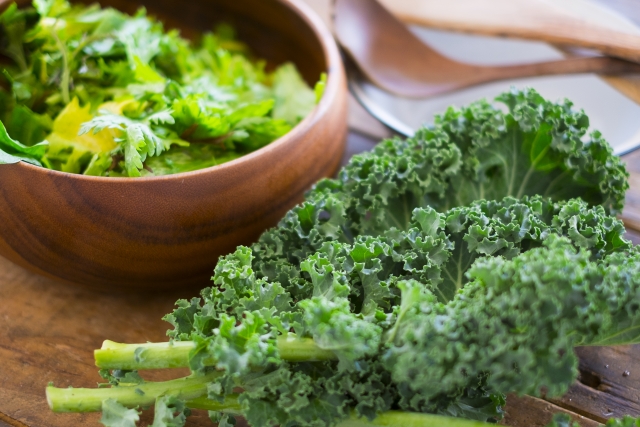
Kale, a leafy green vegetable, belongs to the Brassica family, commonly known as cruciferous vegetables, alongside cabbage and broccoli. Renowned for its nutritional richness and health benefits, kale is a robust source of Vitamin K, Vitamin C, Vitamin A, minerals such as calcium, magnesium, potassium, dietary fiber, and antioxidants.
Its leaves are broad and have a wavy texture, presenting a unique and visually appealing appearance. With a crisp texture, raw kale is distinctive for its crunchy bite. While the leaves are typically dark green, some varieties exhibit a reddish hue, providing vibrant colors for salads and dishes.
Additionally, kale finds versatile usage in smoothies, soups, stir-fries, and more. Whether consumed raw or lightly cooked through steaming or baking, kale offers a delightful and nutritious addition to various culinary creations.
Originating from the Mediterranean coast, kale thrives in warm climates and allows year-round cultivation and harvesting. In Japan, it is cultivated in prefectures such as Ibaraki, Shimane, Ehime, Fukuoka, and Kagoshima. Moreover, kale’s ability to withstand cold temperatures makes it suitable for cultivation in colder regions, ensuring its availability during autumn and winter. Due to its nutritional value and culinary versatility, kale has become a popular choice for health-conscious diets and diverse culinary creations.
Kind of “Kale”
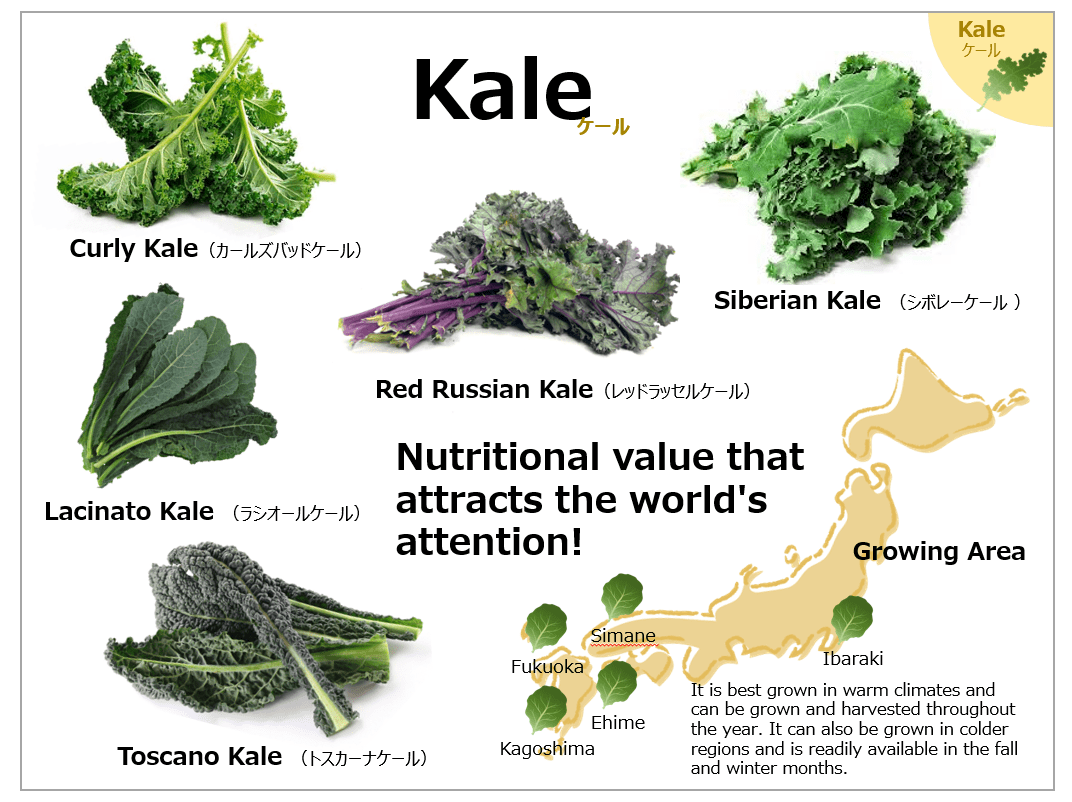
- Curly Kale (カールズバッドケール):
- Curly Kale, as the name suggests, has a unique wavy leaf structure. Its wide green leaves are known for their relatively tender texture. Generally, it combines both deliciousness and visual appeal, making it suitable for use in salads, soups, and smoothies.
- Lacinato Kale (ラシオールケール):
- Lacinato Kale features flat and broad leaves, offering a distinctive texture. It is commonly used in salads and stir-fries, where its unique flavor profile stands out.
- Red Russian Kale (レッドラッセルケール):
- Red Russian Kale is characterized by its distinctive purple or reddish leaves. Due to its visually appealing appearance, it is often used in salads and dips.
- Siberian Kale (シボレーケール):
- Siberian Kale is a cold-resistant variety that thrives in chilly climates. With flat and tender leaves, it is well-suited for soups and salads
- Toscano Kale (トスカーナケール):
- Toscano Kale, a type of Lacinato Kale, is known for its long and narrow leaves. Frequently used in Italian cuisine, it adds flavor to simple dishes.
These are some representative types of kale, and there are various other varieties depending on the region and producer. Since the flavor and uses of kale can vary between types, it’s a good idea to choose based on personal preference and the intended culinary application.
Nutrients in “Kale” and their benefits
❶ Potassium and Its Benefits
Kale is rich in the mineral known as “potassium.” As potassium, like vitamins, cannot be produced within the human body, it is crucial to obtain it through a well-balanced diet. Potassium plays a vital role in balancing the effects of “sodium,” which is abundant in table salt. Here are four recognized benefits and effects of potassium:
- Alleviation of Edema (Swelling):
- Potassium helps reduce fluid retention, aiding in the alleviation of swelling.
- Prevention of High Blood Pressure:
- Maintaining a balance between potassium and sodium can contribute to the prevention of high blood pressure.
- Stroke Prevention:
- Adequate potassium intake has been associated with a lower risk of stroke.
- Bone Density Improvement:
- Potassium plays a role in promoting bone health and may contribute to improved bone density.
For individuals, especially those during lactation, potassium is considered an essential nutrient. Being mindful of including potassium-rich foods in your diet is recommended to enjoy these health benefits!

❷ Vitamin K and Its Effects
Vitamin K is one of the prominent vitamins abundantly found in kale. It is a fat-soluble vitamin with a role in blood clotting. There are two types of vitamin K: vitamin K1, found in green leafy vegetables, seaweed, and green tea, and vitamin K2, synthesized by intestinal bacteria within the body. Here are four recognized effects and benefits of vitamin K:
- Facilitation of Calcium Absorption:
- Vitamin K aids in the absorption of calcium.
- Prevention of Calcium Outflow from Bones:
- It helps prevent the leaching of calcium from bones.
- Hemostatic Properties:
- Vitamin K contributes to clotting, assisting in stopping bleeding.
- Inhibition of Arterial (Vascular) Calcification:
- It helps suppress the calcification that leads to hardening of arteries (blood vessels) from calcium deposition on their inner walls.
Vitamin K activates a calcium-binding protein called osteocalcin in bones, promoting the deposition of calcium and preventing its outflow. Additionally, it stimulates collagen production, making it a vitamin utilized in the treatment of osteoporosis.

❸ Vitamin A and Its Effects
“Kale” stands out as an excellent source of Vitamin A. Vitamin A is a vital nutrient essential for vision, immune function, skin health, and cellular growth and development. Kale contains ample Vitamin A, contributing positively to these aspects of health. Particularly, it supports the normal function of the optic nerve and enhances night vision, aiding in improved visibility during nighttime or in low-light conditions. The recognized effects and benefits of Vitamin A include:
- Enhancement of Optic Nerve Function and Night Vision:
- Vitamin A contributes to the normal function of the optic nerve and improvement of night vision.
- Reinforcement of Immune Function:
- It strengthens the immune system.
- Antioxidant Properties:
- Vitamin A has antioxidant effects, protecting cells from oxidative stress, slowing down cellular aging, and preventing various chronic diseases.
- Strengthening of Skin Epithelium and Inhibition of Dryness and Wrinkles:
- It fortifies the skin’s outer layer, suppressing dryness and wrinkles.
Obtaining Vitamin A through a balanced diet is crucial for healthy growth, vision, immune function, cell differentiation, and maintaining robust skin.

❹ Summary of kale nutrients and their benefits
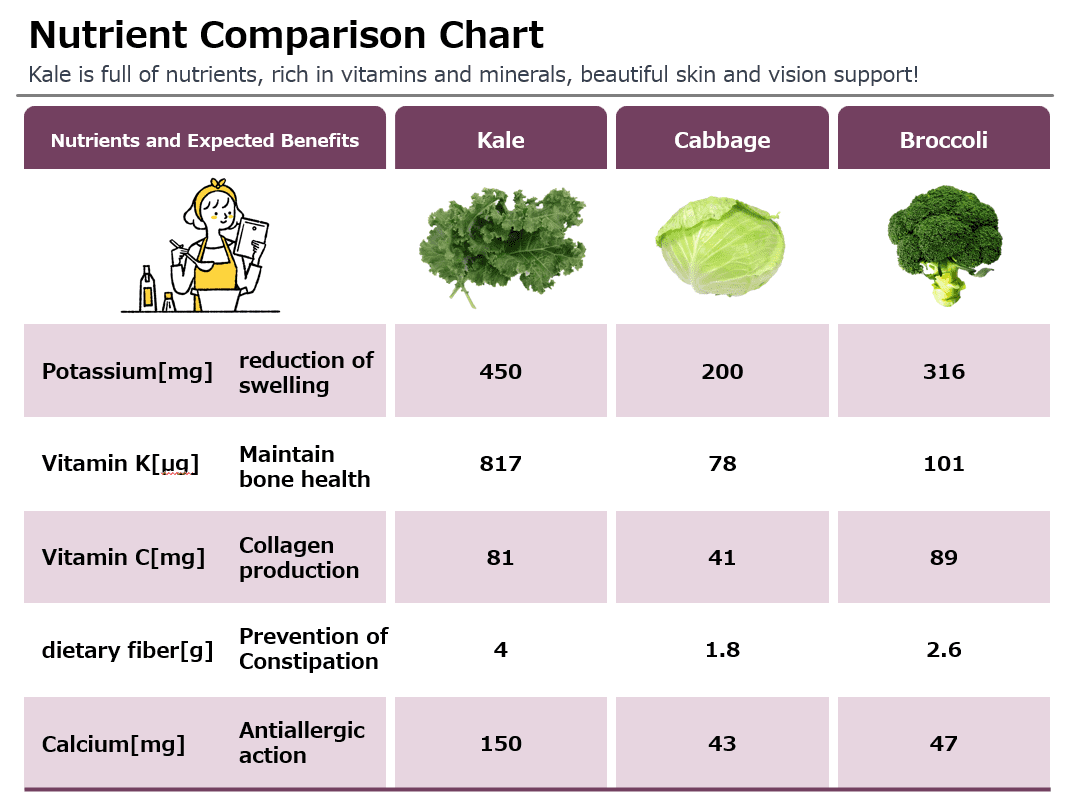
How to choose fresh “Kale”
Tips for Choosing Fresh Kale
When selecting fresh kale, paying attention to four key points is crucial:
- Leaf Appearance Matters: Healthy kale exhibits a vibrant, dark green color and a lush, lively appearance. Choose leaves that are vibrant and well-hydrated, avoiding wilted or discolored ones, as these may indicate lower freshness.
- Consider Leaf Shape and Density: Opt for kale with new leaves radiating from the center and densely packed foliage. This characteristic ensures a crisp and crunchy texture. If leaves are sparse or spread out unevenly, it may indicate a lack of freshness.
- Size of the Leaves: Generally, smaller and tender leaves tend to indicate freshness. However, consider the kale variety, as leaf size can vary. Also, check if the leaves have been exposed to sunlight, as sunlight exposure enhances nutrient content, flavor, and nutritional value.
- Check the Cut End: Ensure that the stem end is firm and not discolored. Select kale with a clean cut, as those with a fresh cut retain more nutrients. Avoid kale with a wilted or darkened cut end, as it may compromise nutritional quality.
By keeping these points in mind, you can select kale that promises optimal flavor and nutritional benefits.
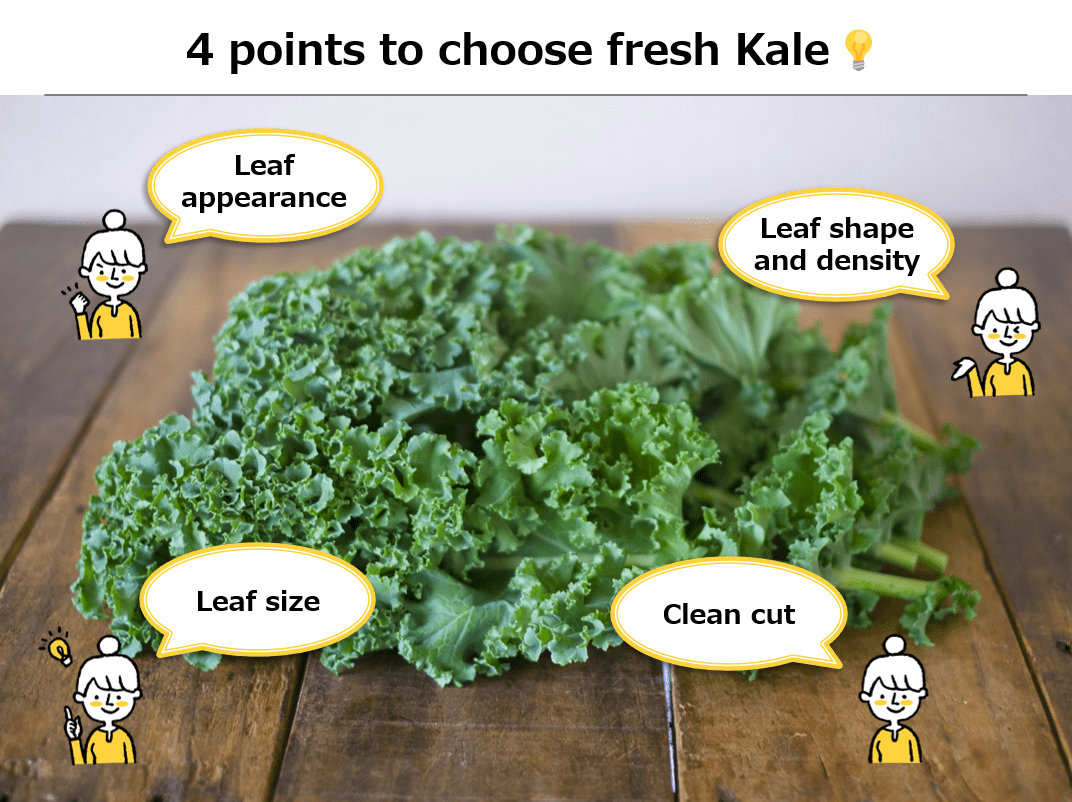
How to preserve “Kale”
Effective Ways to Store Fresh Kale
To ensure kale stays fresh and delicious, understanding proper methods and conditions for storage is crucial. Here are detailed instructions on common methods for storing kale:
- Refrigeration: Kale is best stored in the refrigerator. Place kale in a bag or wrap it in plastic wrap, then store it in the vegetable compartment of the refrigerator. To prevent spoilage, especially in humid conditions, consider wrapping it in kitchen paper or placing it in a breathable bag.
- Freezing: Kale can also be frozen. After washing and thoroughly drying it, cut it into convenient sizes, and then divide it into freezer bags. Freezing allows kale to retain freshness for an extended period while preserving some of its nutritional value.
- Handling Cut Ends: When cutting kale, store it effectively by placing it in a plastic bag. However, for optimal freshness, it is recommended to store kale before cutting. Ensure that cut ends do not dry out during storage, and if there are leftovers, freezing can be a convenient option.
- Combatting Moisture: Kale is sensitive to humidity, so proper humidity control is essential. To reduce moisture absorption, place desiccants in storage containers or wrap kale in kitchen paper to manage humidity effectively.
- Usage Recommendations: It is advisable to use kale as soon as possible. Utilize it in salads, soups, smoothies, or other dishes while it is still fresh.
- Nutritional Changes: Over an extended storage period, kale’s nutritional value may decrease. Vitamins C and K, in particular, are susceptible to oxidation, so consuming kale while fresh is recommended.
These are the fundamental steps for storing kale in a fresh and appetizing state. Optimal storage methods may vary based on individual circumstances, so using kale promptly or choosing effective storage methods for leftovers is essential.
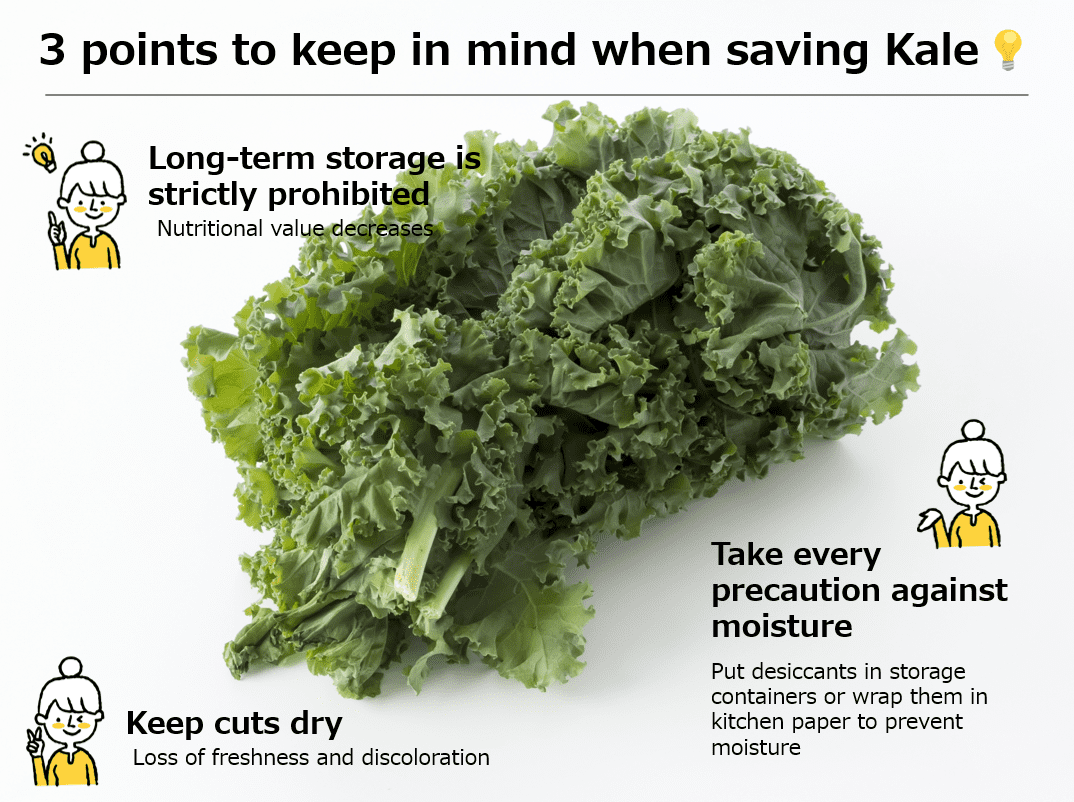
Have you been able to check the nutritional benefits and features of kale? If the identified nutrients and characteristics align with your dinner plans, menu, or contribute to maintaining your health, I would be delighted.
Thank you for your patience. Now, let’s get started with the ingredients and recipe for “Kale Salad with Japanese Dressing”.
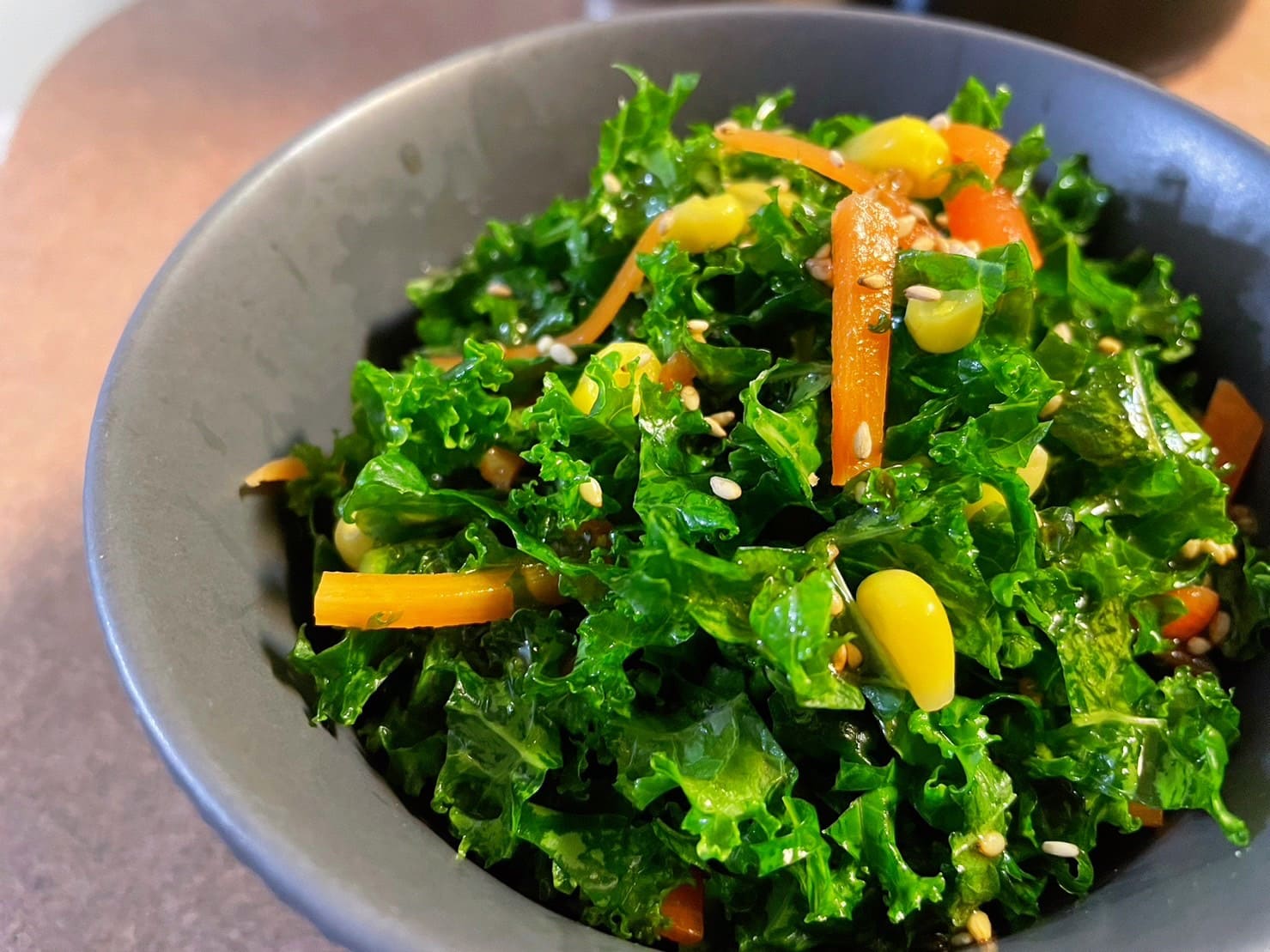
◆Ingredients
- Kale: 3-4 leaves
- Carrot: 1/2 piece
- Corn: 1 can
- Extra Virgin Olive Oil: 4 tablespoons
- Soy sauce: 2 tablespoons
- Vinegar: 2 tablespoons
- Honey: 1 teaspoon
- Scrambled sesame seeds: as needed
◆Instructions
1
- Remove the shafts from the kale [3-4 pieces] and cut into 2 cm lengths.
- Soak the cut kale in water to remove dirt, then drain.
- Cut off the root of the carrot [1/2 carrot], peel it, keep the cut end down, and cut it into 1 cm pieces. Cut further into strips 1.5 cm wide along the fiber, cut end down.
- Cover carrots with plastic wrap and microwave for 30 seconds.
- Transfer the corn [1 can] to a colander and drain.
- In a large bowl, combine the soy sauce [2 tablespoons], vinegar [2 tablespoons], honey [1 teaspoon], and sesame seeds [as needed] and mix well with a whisk.
- After mixing, add Extra Virgin Olive Oil [4 tablespoons] a little at a time and stir to combine.
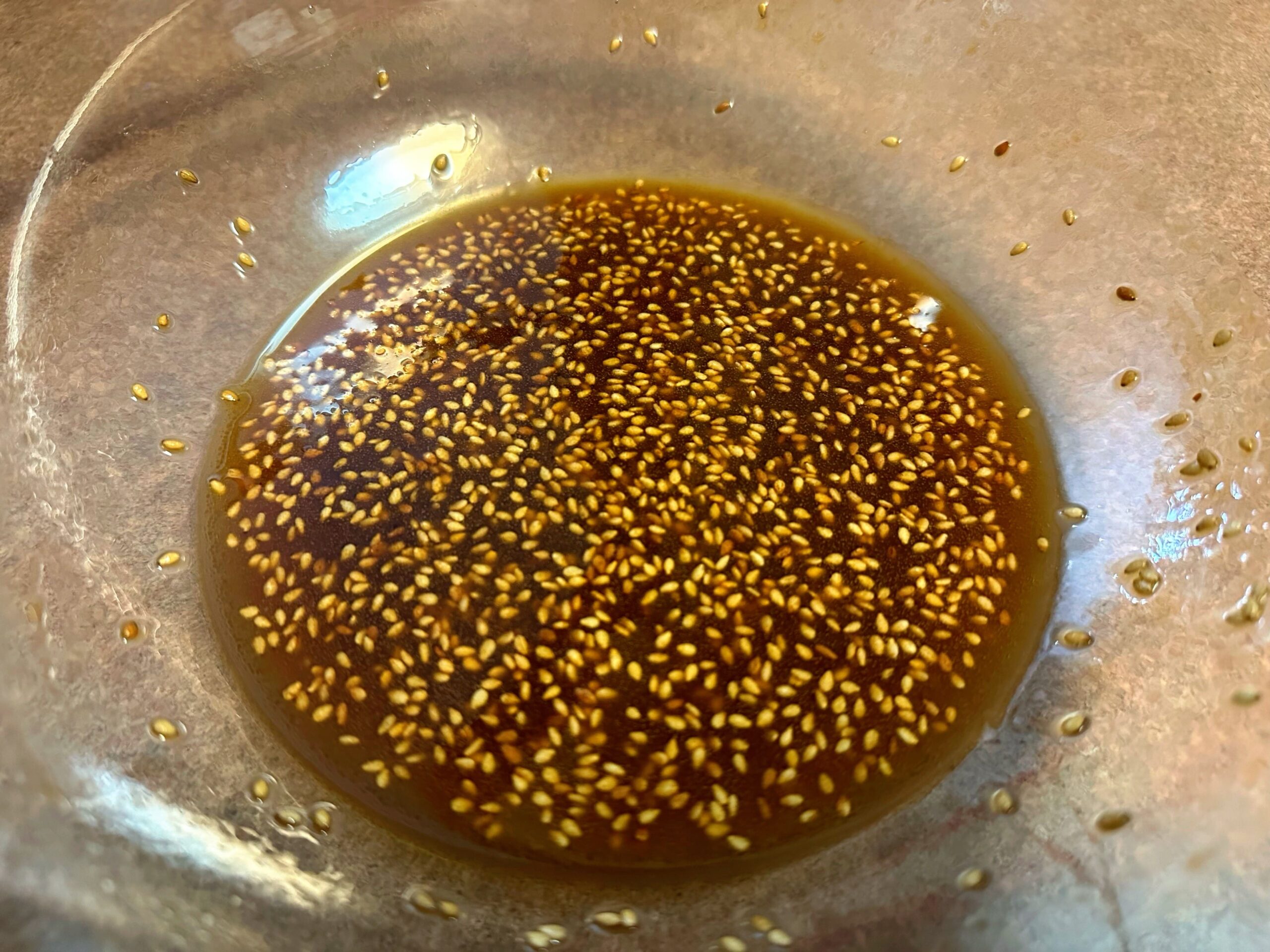
2
- When the dressing is finished, add the kale, carrots, and corn and toss thoroughly.
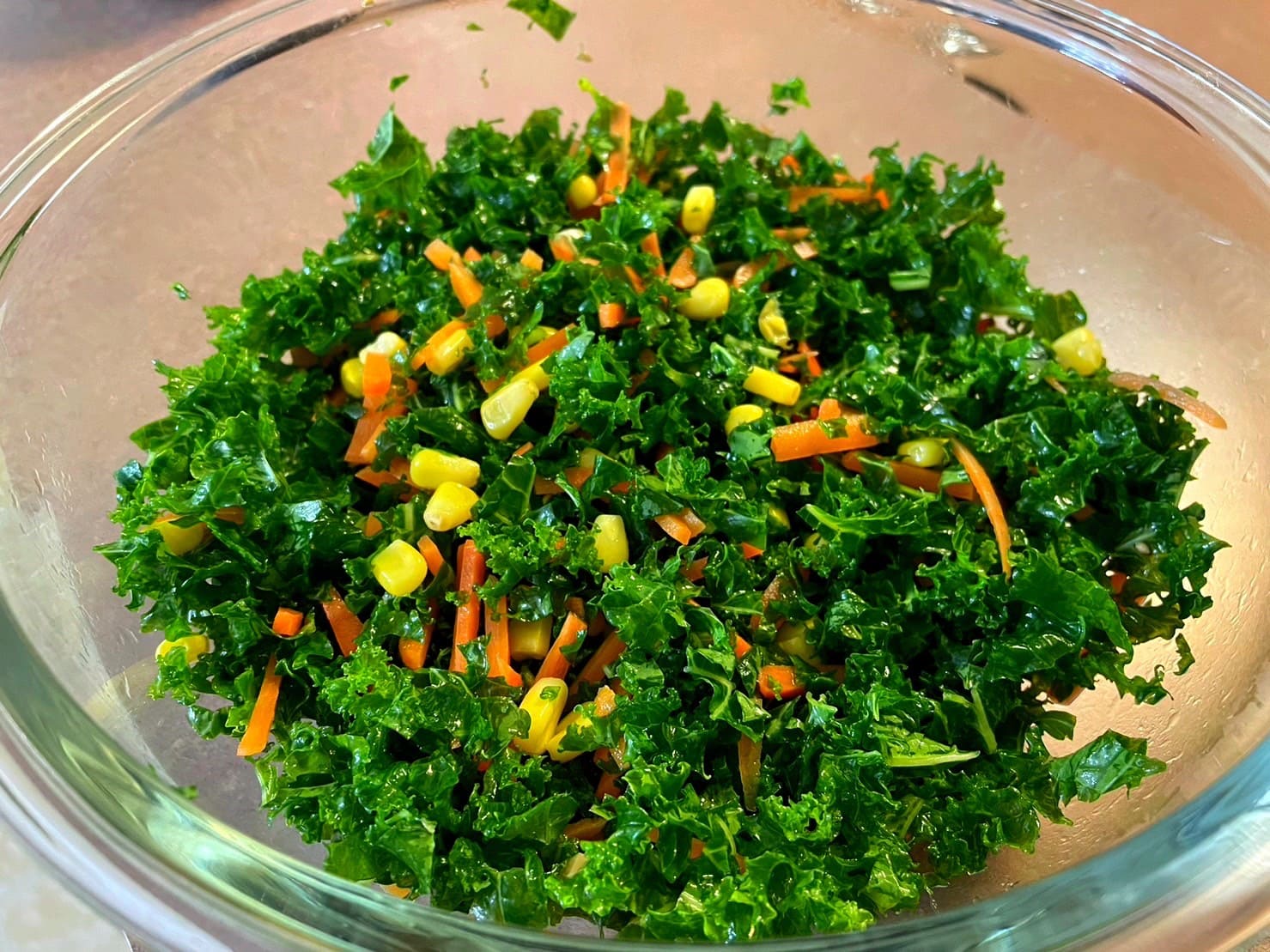
3
- Place in a serving bowl and it is ready to serve.
Thank you very much for reading until the end. If you enjoyed this, let’s meet again with a different recipe. Until then, everyone, have a wonderful day and let’s keep cooking!
Kale is globally recognized as a healthy ingredient, drawing attention for its high nutritional value, but it also has lesser-known anecdotes. Here are some fascinating tales associated with kale:
- Ancient Superfood: Kale, surprisingly, has a very ancient history. Around 2000 BCE, it was already cultivated in ancient Egypt, Greece, and Rome, praised for its health benefits. Ancient people were aware of its nutritional value and incorporated it into their cuisine.
- Role during World War II: In certain regions, kale became a precious commodity during World War II. To address food shortages during the wartime, people actively cultivated kale and included it in their meals. Recipe books from that era showcase creative dishes featuring kale.
- Reevaluation and Boom: Entering the 2000s, as the focus on healthy ingredients increased, kale underwent a reevaluation, becoming an indispensable part of health-conscious diets. Particularly used in smoothies, salads, soups, its unique flavor, and crisp texture endeared it to many.
- Variety of Kale Types: Kale comes in many varieties, each with its unique characteristics. While varieties like Curly Kale or Dino Kale are commonly known, there are numerous kale types with different colors and shapes. For instance, there are pink or purple varieties that add vibrant colors to the dining table.
- Nutrition and Health Benefits of Kale: Despite being low in calories, kale is rich in nutrients such as Vitamin A, Vitamin C, Vitamin K, fiber, and minerals. This contributes to various health benefits, including support for vision, improved immune function, promotion of bone health, and antioxidant effects.
- Kale’s Regeneration Technology: Kale can regenerate, allowing new leaves to grow after harvesting. This capability enables repeated harvesting from a single kale plant, making it a sustainable food source garnering attention.
- Kale’s Influence on Literature and Art: Kale not only influences cuisine but also literature and art. In some literary works and paintings, kale appears as a symbol of rich color and a healthy image. Thus, kale is valued not only as a food ingredient but also as a cultural element. With its unique history and characteristics, kale has influenced various aspects of culture and history.
- Kale Internet Memes: Due to its health benefits, kale has become the subject of humorous memes and jokes on the internet. For example, expressions like “Kale is the solution to all problems” have circulated, becoming a source of laughter within the kale enthusiast community.
- Regional Transformations of Kale: The popularity of kale varies by region, with some areas having a long-standing tradition of incorporating kale into their cuisine. In regions like the Mediterranean and parts of Asia, kale or similar varieties are integrated into traditional meals.
- Creative Uses of Kale: Kale extends beyond being just a salad ingredient and is creatively utilized in various ways. Kale chips, baked in the oven to a crispy perfection, have become a popular and healthy snack. Additionally, adding kale to smoothies or juices provides a flavorful accent to beverages.
- Contribution to the Earth’s Environment: Kale is considered environmentally friendly due to its relatively easy cultivation and fast growth, resulting in minimal environmental impact. The use of regenerative techniques, allowing multiple harvests from a single plant, contributes to its recognition as a sustainable choice from a sustainability perspective. This highlights kale as a potential sustainable option for the future of food.
- Kale Festivals: The popularity of kale has evolved into festivals in some regions. Events celebrating the harvest of kale or competitions featuring kale-based dishes bring local communities together. This showcases how kale is intricately linked with local communities in the realm of food culture.
These points highlight the diverse facets of kale, showcasing its impact beyond the culinary realm, including its cultural significance, regeneration capabilities, and even its humorous portrayal on the internet.
The untold anecdotes of kale bring us many learnings and fascinating discoveries through its history, cultural impact, and role in culinary culture. This is indeed an example of how an ingredient is closely intertwined with human life and history, going beyond being a mere source of nutrition. Here are some interesting aspects of kale:
- Kale Art: Due to its unique leaf shape and beautiful green color, kale is utilized as a material for art. Some artists create sculptures and abstract artworks using kale, gaining attention both online and in exhibitions.
- Kale Freezing Technology: To maintain the freshness of kale, some farmers and food technology companies have introduced new freezing techniques. This preserves the high nutritional value of kale, making long-term storage possible and enhancing convenience for consumers.
- Evolution of Kale: Kale has evolved over time, giving rise to new varieties. Examples include Red Kale and Lacinato Kale, particularly known for its soft leaves, making kale suitable for a variety of uses.
- Kale Cooking Contests: In certain regions, contests are held where unique dishes featuring kale are competed. Professional chefs and amateurs gather to showcase creative and delicious dishes with kale as the main ingredient.
- Surprising Flavors of Kale: While kale has a distinct flavor, it can be a hidden star in cooking. For instance, adding kale to smoothies enhances the fresh and refreshing taste, complementing fruits and transforming into a delicious drink.
- Kale Food Trends: Kale has become part of not just a temporary trend but a long-term trend in food. This is a result of the increasing focus on health and growing interest in diverse diets.
- Variation in Kale Dishes: Kale is not limited to just salads but has been creatively incorporated into various dishes. From kale chips to pasta with kale, and kale smoothies, ideas that leverage its flexibility and nutritional value keep emerging.
These interesting facets and new uses of kale reflect the evolution of culinary culture and changes in health consciousness. Kale continues to be widely cherished in cooking, art, and trends due to its unique characteristics and deliciousness.
The history of kale is very old and has been visible in many different cultures. Below is a summary of the main points regarding the history of kale:
- Origin: Kale is believed to have originated in the Mediterranean region. Around 2000 BCE, it was cultivated in ancient Egypt, Greece, and Rome. In Greece, athletes participating in the Olympic Games were known to consume kale to enhance their strength.
- Ancient Rome and Medieval Europe: During ancient Roman times, kale was a common and widely used ingredient, and its importance continued into medieval Europe. Due to its resilience in cold climates, kale became popular in Northern Europe and the United Kingdom.
- Introduction to America: Kale was introduced to North America in the 17th century. Even during the colonial period in America, kale found its way onto dining tables, with its nutritional benefits being appreciated.
- Significance During Wartime: In World War II, kale gained special attention during periods of food shortages due to its rich nutritional content. Efforts were made to supplement the lacking nutrients.
- Nutritional and Health Boom: Entering the 21st century, kale experienced a reevaluation and gained attention as a superfood with the increasing health consciousness. Its high nutritional value and low-calorie content made it popular for diet and health-focused diets.
- Integration into Culinary Culture: Kale is now integrated into modern culinary culture, featuring in various dishes such as salads, smoothies, and soups. Its distinct flavor and crispy texture are enjoyed on many dining tables.
- Diverse Varieties: Kale comes in various varieties, each with different shapes and colors. While commonly known varieties include Curly Kale and Lacinato Kale, there are also pink and purple kale varieties, adding diversity to its appeal.
Throughout different eras, kale has been cultivated in various cultures, and its unique flavor and nutritional benefits have endeared it to people over time.
